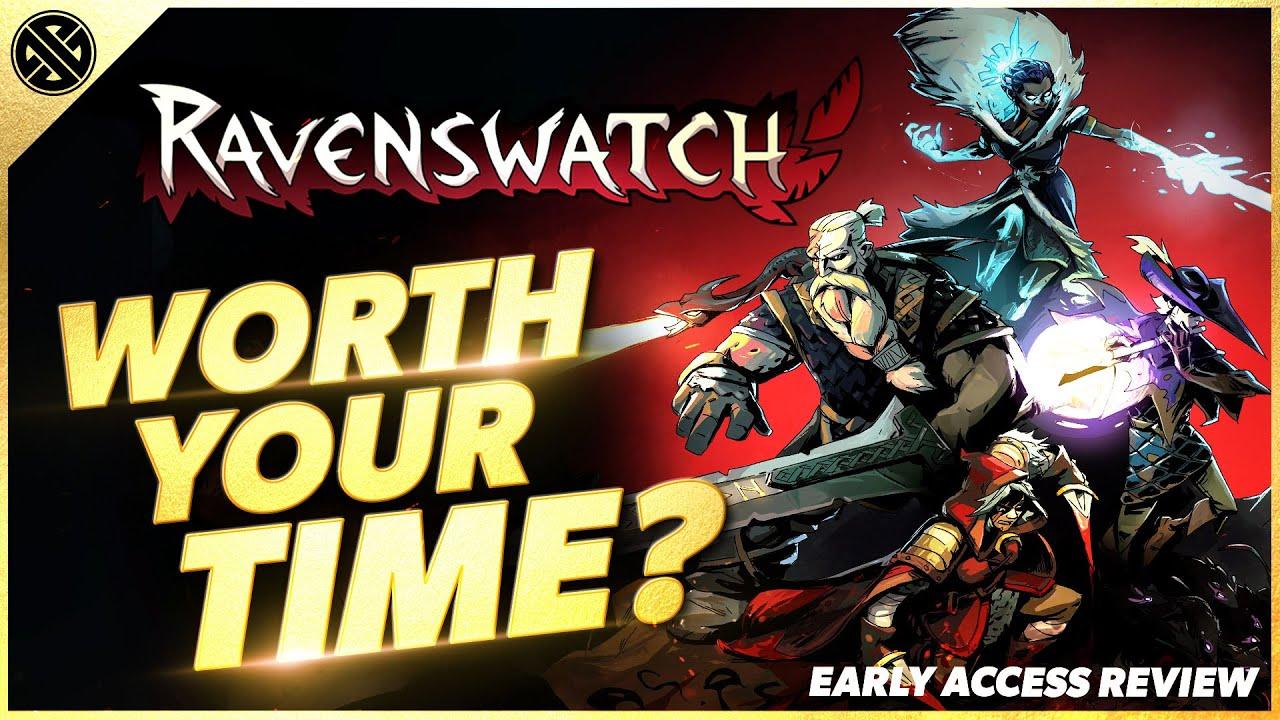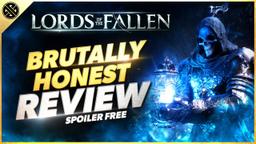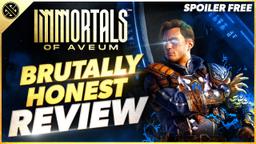Ravenswatch
Written by - Codiak
Updated: June 20, 2023
|
Posted: April 4, 2023

For those that don’t know I have a passion for indie roguelike games. The formula just clicks on so many different levels for me. That’s why when the team developing Ravenswatch reached out, I jumped at the chance to play the game early.
The developers are no strangers to the genre. Their last game, Curse of the Dead Gods, was a game we reviewed, and loved, here on the channel. Ravenwatch is clearly built on the foundation that was established with Curse of the Dead Gods, but that’s where the similarities end. The game is very much its own unique thing, taking the genre in a bold new direction, one that I think will pay off huge for the team.
GAME LOOP BREAKDOWN
So, let’s get you caught up to speed. In Ravenswatch the first thing you’ll do is pick a hero. Many of them will be familiar to you as they’re based on characters from popular folk lore. Scarlet for example is designed like Little Red Riding Hood albeit with a twist. That’s what’s so interesting about each hero, they’re familiar enough to peak your interest, but they have little quirks and nuances about them that help them stand out.
I’ll be honest, of the 6 heros we had access to at the early access launch each of them felt incredible. They all have vastly different and interesting movesets, and fit nicely into a group composition. While each hero has elements of either a warrior, rogue, or mage, using those labels to describe these Heros vastly undersells them.

Regardless of who you choose you’ll have access to a unique set of abilities, and it’s really interesting how the team chooses to categorize each individual skill across the roster. Each hero comes with a trait, something tied to the identity of the hero in question, an attack, a power, a special, a defense and an ultimate ability.
Overall, the moveset is fantastic, and each hero plays completely different, but trying to understand what ability is categorized as what, and how those ties into the upgrade system is a mess.
This is easily my biggest complaint with the game, and it’s not even about the gameplay, it’s about the user experience. On multiple occasions elements of the UI just simply doesn’t give us enough information to understand everything we need to about a specific ability. After repeatedly playing the game it all clicked into place, but it should never have been a mystery to begin with.
This is a perfect example of a small issue causing a big problem because for newer players, trying to understand what Ravenswatch is, and more importantly, how to get better at it, this is going to be a point of frustration.
but trying to understand what ability is categorized as what, and how that ties into the upgrade system is a mess.
Let me give you a quick example. Aladdin, one of the 6 characters we had access to ahead of launch, has an ability called somersault. In the tooltip it reads, crossed enemies become vulnerable for 3 seconds. What does vulnerable mean you might be wondering? Well, we have no idea because it’s not easily accessible information. Of course, we can assume this is a universal term from other games, but that’s not something gamers of various skills levels may know. Leaving it up to the player to assume, isn’t a great design decision in my opinion. After some trial and error, you can figure it out, vulnerable makes enemies take slightly more damage, but the fact that it’s not clear right here when trying to understand a character’s abilities is frustrating.
Luckily this is a relatively easy fix, the team just needs to go back and look at the user experience before a round even starts, focusing on presenting all relevant information in a way that’s clear and easy to understand.
That issue aside I think the Passtech team is really onto something with Ravenswatch. The game itself is a ton of fun to play. I’d even go so far as to say this could very well be the Indie gem of 2023.
What makes me say that? Well, a few important things. First off the idea of moving room to room through a procedurally generated dungeon is a thing of the past. Instead, Ravenswatch decided to go with a more open-world concept with various points of interest that players need to discover and complete. This is a really big change for the genre, and it plays out in such a fantastic way. Once you understand the concept you get to start making decisions about which points of interest you prioritize. You don’t have time to do everything on the map so you have to make a choice.
Speaking of time, that’s another thing that’s different, and I believe enjoyable about the game. Your time on the map is limited. You can utilize however much time you’re given, but once that runs out its boss time, and you’re teleported to the final encounter of that area. This is such a great way to control the pace of a round, ensuring that it never gets too long, but because you also have the option to activate the boss at any time you also don’t have to wait for the timer to run out. It’s smart design.
This could very well be the indie gem of 2023
A lot of the other trappings of the game, specifically the hero progression system, are more traditional in their presentation. During a round your hero can level up. When they level up players get to choose one upgrade to unlock. Most of the time you’re given two options, and those options are pulled randomly from your overall pool of upgrades. Similar to other roguelike games this is where the perm-progression factors in. Every time you play a round, you’ll gain some overall xp for the hero that you played. Every time you level up you’ll unlock a few new upgrades that you can then find when in future runs.
Ultimately what this is going to boil down to is more flexibility for how you build out your hero. You may like certain elements of a moveset better than others, so have more upgrades available, you’ll have more choice each time you level up. Right now things are pretty limited, but keep in mind the game’s just launching into early access. It’s pretty clear just based on the individual hero screens that much more is coming.

On one hand you have hero upgrades, on the other you have items, and I’ll admit the line between the two was a bit confusing at first. Items aren’t really items, they’re just more upgrades, albeit a bit more generic. That’s really the issue with items in general, they’re boring and the way they’re presented is completely forgettable. While the items themselves have unique names their icons are pulled from a pool of less than 10 so it’s hard to distinguish between them. This could easily be fleshed out by adding some new icon art throughout the course of the open beta, because right now it’s just a little forgettable.
HEROS
What’s absolutely not forgettable is the actual gameplay itself. The team at Passtech truly understands what’s most important about a game like this. Hero design, enemy design, and the moment-to-moment gameplay. Across the board Ravenswatch delivers, and my small gripes aside after just a few rounds it was clear this is a game to watch.
First off the ability to play in a part of up to four is incredible. It’s roguelike meets casual co-op and it absolutely works. After playing with our team, it was hard to go back to playing solo because the experience is just elevated that much more when in a group. That’s not to say the solo experience is bad, it’s not, but if we’re talking fun factor, partying up is a gamechanger.
What’s most striking about the moment-to-moment gameplay is just how buttery smooth it all is, and that starts with the heros. Not only is each folk-inspired hero incredibly unique, but their moveset works in harmony perfectly. It’s clear the developers have a firm grasp of this, and they even manage to do a few completely new things as well. Heros like Melusine have such an innovative move sets that really gets me excited about future heros they’re going to add into the game.
Just as a sort of high-level overview:
- Scarlet is a flippy stabby rogue type hero, but once the sun sets she turns into a werewolf that has harder hitting abilities while sacrificing a bit of speed
- The Pied Piper is a ranged class that uses a barrage of musical attacks to weaken and damage foes…and he can also send out his army of rats to take down foes
- Beowulf is a chunky frontline warrior that can infuse his abilities with fire from his dragon companion
- The Snow Queen is a unique take on a mage where her abilities chill enemies and then players can shatter them dealing massive damage
- Aladdin is a melee hero that can tap into the power of his magical lamp to call on the power of the jinn to aid him in combat
- And Melusine is a ranged caster that uses a floating wisp to deal damage to enemies while she remains stationary

Each hero plays differently but their moveset is almost perfectly balanced with each ability playing off another in some sort of way and this is only amplified as you level up and start unlocking upgrades. There’s something to be said about the pacing of the action. Some might find it a bit too slow, but you do get use to that over time.
Part of the reason the heros work so well is because on the receiving end of each attack is an array of enemies that are not only interesting, but well designed themselves. Each enemy is easy to identify and brings primarily one specific skill to battle. As enemies come together in small armies you have to quickly identify what you’re up against and prepare accordingly. Outside of one or two abilities I found that as a whole, enemies are well balanced, challenging, and satisfying to defeat. At the beginning of a round it’s pretty obvious that enemies hold all the power, but there’s a very noticeable shift in power once you gain enough upgrades and that’s when the game kicks the fun factor into high gear.
It’s almost like the hunted becomes the hunter. At the start of the game you’re cautiously dancing around the outskirts of large enemy groupings afraid to overcommit because you just don’t have the firepower, but at some point, once that power dynamic shifts, you feel almost empowered to dive headfirst into the fray and see just how much damage you can do in one fell swoop. It’s a ridiculously satisfying feeling that I’m sure will become even more cathartic as more content gets added into the game.
THE CONTENT GAP
This leads me to my last major point, content, or lack thereof. What’s impressive is the 6 heros that are available for early access launch. They all feel polished and are each fun to play in their own right. What’s disappointing is the lack of everything else. At launch there is one map to play, a limited set of pois, and only one boss. I’ll be honest I seriously question the approach here. There’s simply not enough for players to do, not enough of a reason to keep playing, at this point. There are multiple layers of difficulty and that does change things up slightly, but not enough to hold the attention of more casual players.
Let me be clear, the game is fantastic, and while I can usually deal with the early access aspect of these sorts of games the team is really testing the limits here. I have no problem supporting a game that I genuinely enjoy, and hope succeeds come 1.0 launch, but that’s not the case for everyone, and to a fair few player they’re going to pick up Ravenswatch, realize only one level and one boss are available, cry foul, and refund the game. To be honest I hate that, because as I said at the start, this game has the potential to be the Indie gem of the year.
There’s simply not enough for players to do, not enough of a reason to keep playing, at this point.
The only small saving grace here is that the developers plan on communicating something at launch about the trajectory of early access. I couldn’t quite get them to confirm a roadmap would be coming on day one, but at least they’ll be saying something on the matter. From a strategy point of view, I think the team is really doing themselves a disservice here. They have something really special with Ravenswatch and I’m worried the rush to get it to market without more content could be an issue.
CONCLUSION
You might be picking up on the fact that I’m having a bit of an internal crisis as I try and eloquently talk about this game. It’s tough because on one hand I absolutely love the moment-to-moment gameplay, the way the team has changed up the roguelike formula, and the overall potential this game brings to the table. On the flip side there’s just not enough here yet to justify spending money. Is it worth buying from my perspective? Absolutely. I want to support these developers and I want to see Ravenswatch succeed but is that the case for every casual player out there wondering what to spend their hard-earned cash on?No, it’s not.
Ultimately Ravenswatch is a “must watch” game. If you enjoy the roguelike genre and are looking for a unique experience, there is no doubt in my mind this game will be stellar once more content is added.






